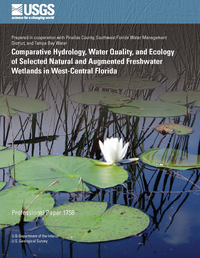Comparing altered wetlands to natural wetlands in the same region improves the ability to interpret the gradual and cumulative effects of human development on freshwater wetlands. Hydrologic differences require explicit attention because they affect nearly all wetland functions and are an overriding influence on other comparisons involving wetland water quality and ecology. This study adopts several new approaches to quantify wetland hydrologic characteristics and then describes and compares the hydrology, water quality, and ecology of 10 isolated freshwater marsh and cypress wetlands in the mantled karst landscape of central Florida. Four of the wetlands are natural, and the other six have water levels indirectly lowered by ground-water withdrawals on municipally owned well fields. For several decades, the water levels in four of these altered wetlands have been raised by adding ground water in a mitigation process called augmentation. The two wetlands left unaugmented were impaired because their water levels were lowered. Multifaceted comparisons between the altered and natural wetlands are used to examine differences between marshes and cypress wetlands and to describe the effects of augmentation practices on the wetland ecosystems.
In the karstic geologic setting, both natural and altered wetlands predominantly lost water to the surficial aquifer. Water leaking out of the wetlands created water-table mounds below the wetlands. The smallest mounds radiated only slightly beyond the vegetated area of the wetlands. The largest and steepest mounds occurred below two of the augmented wetlands. There, rapid leakage rates regenerated a largely absent surficial aquifer and mounds encompassed areas 7-8 times as large as the wetlands.
Wetland leakage rates, estimated using a daily water-budget analysis applied over multiple years and normalized as inches per day, varied thirtyfold from the slowest leaking natural wetland to the fastest leaking augmented wetland. Leakage rates increased as the size of the flooded area decreased and as the downward head difference between the wetland and the underlying Upper Floridan aquifer increased. Allowing one of the augmented wetlands to dry up for about 2.5 months in the spring of 2004, and then refilling it, generated a net savings of augmentation water despite the amount of water required to recreate the water-table mound beneath the wetland. Runoff from the surrounding uplands was an important component of the water budget in all of the unaugmented wetlands and two of the augmented wetlands. At a minimum, runoff contributed from half (45 percent) to twice (182 percent) as much water as direct rainfall at individual wetlands.
Wetland flooded areas, derived using wetland water levels and bathymetric data and presented as a percentage of total wetland area, were used to compare and contrast hydrologic conditions among the 10 wetlands. The percentages of the natural wetland areas that flooded during the study were comparable, despite differences in the sizes of the wetlands. The percent flooded area in each wetland was calculated daily over the study period and monthly for up to 16 years using historical water-level data. Historical flooding in the natural wetlands spanned a greater range in area and had more pronounced seasonality than historical flooding at either the impaired or augmented wetlands. Flooding in the impaired and natural wetlands was similar, however, during 2 years of the study with substantially reduced well-field pumping and above average rainfall.
Comparisons indicated several hydrologic differences between the marsh and cypress wetlands in this study. The natural and impaired marshes leaked at about half the rate of the natural and impaired cypress wetlands, and the marshes collectively were underlain by geologic material with lower vertical leakance values than the cypress wetlands. The natural marshes had higher evaporation rates compared to cypress


